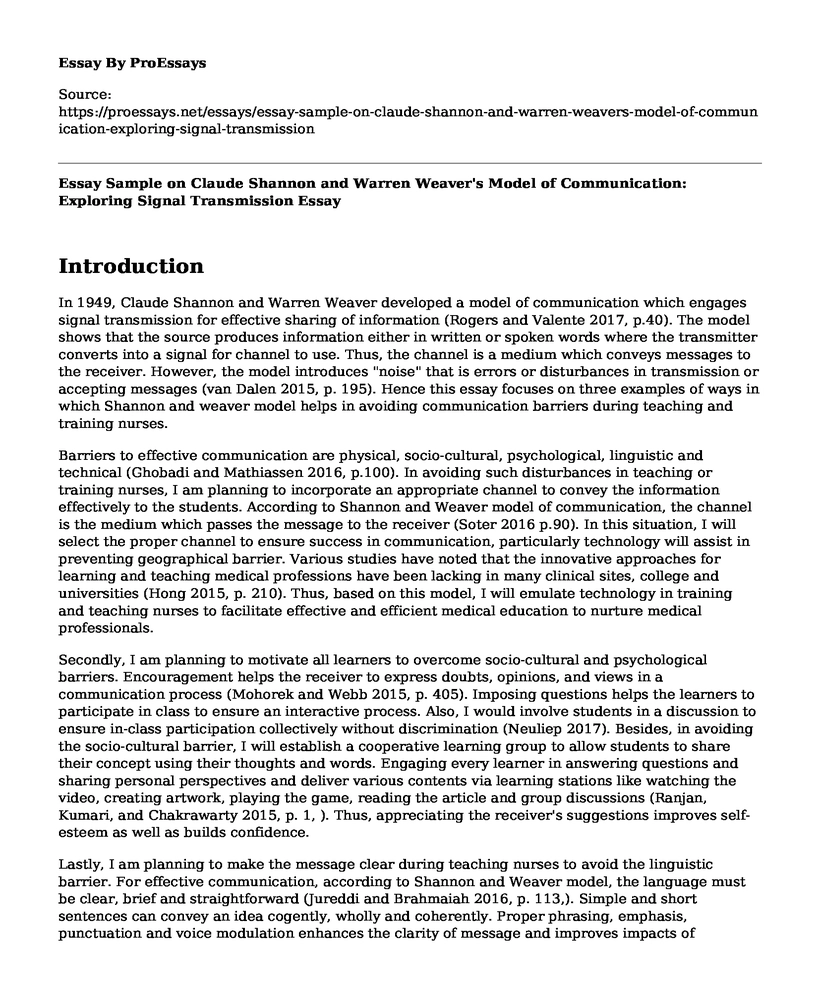Introduction
In 1949, Claude Shannon and Warren Weaver developed a model of communication which engages signal transmission for effective sharing of information (Rogers and Valente 2017, p.40). The model shows that the source produces information either in written or spoken words where the transmitter converts into a signal for channel to use. Thus, the channel is a medium which conveys messages to the receiver. However, the model introduces "noise" that is errors or disturbances in transmission or accepting messages (van Dalen 2015, p. 195). Hence this essay focuses on three examples of ways in which Shannon and weaver model helps in avoiding communication barriers during teaching and training nurses.
Barriers to effective communication are physical, socio-cultural, psychological, linguistic and technical (Ghobadi and Mathiassen 2016, p.100). In avoiding such disturbances in teaching or training nurses, I am planning to incorporate an appropriate channel to convey the information effectively to the students. According to Shannon and Weaver model of communication, the channel is the medium which passes the message to the receiver (Soter 2016 p.90). In this situation, I will select the proper channel to ensure success in communication, particularly technology will assist in preventing geographical barrier. Various studies have noted that the innovative approaches for learning and teaching medical professions have been lacking in many clinical sites, college and universities (Hong 2015, p. 210). Thus, based on this model, I will emulate technology in training and teaching nurses to facilitate effective and efficient medical education to nurture medical professionals.
Secondly, I am planning to motivate all learners to overcome socio-cultural and psychological barriers. Encouragement helps the receiver to express doubts, opinions, and views in a communication process (Mohorek and Webb 2015, p. 405). Imposing questions helps the learners to participate in class to ensure an interactive process. Also, I would involve students in a discussion to ensure in-class participation collectively without discrimination (Neuliep 2017). Besides, in avoiding the socio-cultural barrier, I will establish a cooperative learning group to allow students to share their concept using their thoughts and words. Engaging every learner in answering questions and sharing personal perspectives and deliver various contents via learning stations like watching the video, creating artwork, playing the game, reading the article and group discussions (Ranjan, Kumari, and Chakrawarty 2015, p. 1, ). Thus, appreciating the receiver's suggestions improves self-esteem as well as builds confidence.
Lastly, I am planning to make the message clear during teaching nurses to avoid the linguistic barrier. For effective communication, according to Shannon and Weaver model, the language must be clear, brief and straightforward (Jureddi and Brahmaiah 2016, p. 113,). Simple and short sentences can convey an idea cogently, wholly and coherently. Proper phrasing, emphasis, punctuation and voice modulation enhances the clarity of message and improves impacts of communication (Thomson et al., p.640). The element of redundancy should be introduced to ensure the message is clear where technical or tricky words require to be replaced with simpler expressions. Hence, I will convey clear information or messages to the student to avoid repetition. In understanding the effectiveness of communication during the teaching process, I will assess the students to know their reactions towards assignments, teaching material and methods.
Conclusion
During the teaching or training process, barriers to effective communication basing Shannon and Weaver model can deter the overall communication process. For example, socio-linguistic barriers such as inadequate translation, ambiguous words, faulty expression and inappropriate words affect the passing of information. Thus, I am planning to utilize Shannon and weaver model to avoid barriers during teaching or training nurses.
Referencing List
Ghobadi, S. and Mathiassen, L., 2016. Perceived barriers to effective knowledge sharing in agile software teams. Information Systems Journal, 26(2), pp.95-125. https://doi.org/10.1111/isj.12053
Hong, B.S., 2015. Qualitative analysis of the barriers college students with disabilities experience in higher education. Journal of College Student Development, 56(3), pp.209-226. https://doi.org/10.1353/csd.2015.0032
Jureddi, D.N. and Brahmaiah, N., 2016. Barriers to effective communication. Journal of English Language and Literature, 3(2), pp.114-115. Obtained from http://joell.in/wp-content/uploads/2016/03/114-115BARRIERS-TO-EFFECTIVE-COMMUNICATION.pdf
Mohorek, M. and Webb, T.P., 2015. Establishing a conceptual framework for handoffs using communication theory. Journal of surgical education, 72(3), pp.402-409. https://doi.org/10.1016/j.jsurg.2014.11.002
Neuliep, J.W., 2017. Intercultural communication: A contextual approach. Sage Publications.
Ranjan, P., Kumari, A. and Chakrawarty, A., 2015. How can doctors improve their communication skills?. Journal of clinical and diagnostic research: JCDR, 9(3), p.JE01. https://doi.org/10.7860/JCDR/2015/12072.5712
Rogers, E.M. and Valente, T.W., 2017. A history of information theory in communication research. In Between communication and information (pp. 35-56). Routledge.
Soter, M., 2016. Theoretical Modelling of Intercultural Communication Process. Journal of Advocacy, Research and Education, (2), pp.87-92. Obtained from http://www.kadint.net/journals_n/1473284978.pdf
Thomson, K., Outram, S., Gilligan, C. and Levett-Jones, T., 2015. Interprofessional experiences of recent healthcare graduates: A social psychology perspective on the barriers to effective communication, teamwork, and patient-centred care. Journal of interprofessional care, 29(6), pp.634-640. https://doi.org/10.3109/13561820.2015.1040873
Van Dalen, J., 2015. Experiential Learning. Clinical Communication in Medicine, pp.193-199. https://doi.org/10.1002/9781118728130.ch30
Cite this page
Essay Sample on Claude Shannon and Warren Weaver's Model of Communication: Exploring Signal Transmission. (2023, Feb 17). Retrieved from https://proessays.net/essays/essay-sample-on-claude-shannon-and-warren-weavers-model-of-communication-exploring-signal-transmission
If you are the original author of this essay and no longer wish to have it published on the ProEssays website, please click below to request its removal:
- Essay on the Objectification of Women's Bodies
- How People Form Impressions of Who They Are and How Communication Affects Self-Perceptions
- Increasing Safety and Security in Children Environments Essay
- Negotiation Style and When Negotiation Is Appropriate Paper Example
- Essay Example on Interpersonal, Verbal & Written Communication: Strengthening Relationships
- Reading in English as a Foreign Language - Essay Example
- Essay Sample on Race and Gender







